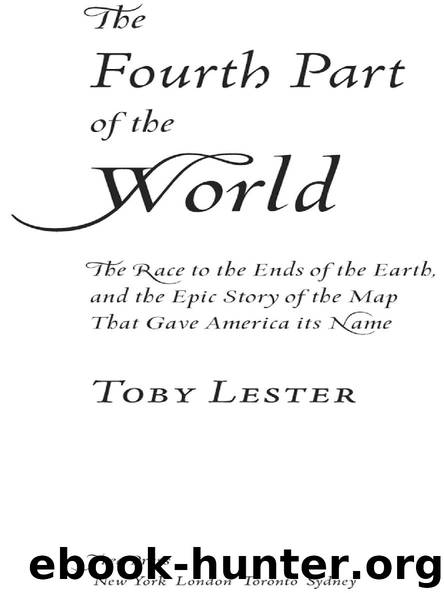The Fourth Part of the World by Toby Lester

Author:Toby Lester
Language: eng
Format: epub
Publisher: Free Press
Published: 2009-07-15T00:00:00+00:00
• Cuba, Hispaniola, and the Caribbean •
CHAPTER FOURTEEN
THE ADMIRAL
He saw so many islands that he couldn’t count them … and he says that he thinks that these islands are those innumerable ones that are found on the world maps at the end of the Far East.
—Bartolomé de Las Casas, summarizing the November 14, 1492,
entry in Columbus’s now-lost Journal of the First Voyage
IN MAY, COLUMBUS traveled to the port town of Palos, not far from Fray Antonio’s monastery at La Rábida, and there he spent a busy summer preparing for his voyage: leasing ships, hiring crew, gathering provisions, studying books and maps. By the end of July he had three fully outfitted vessels—the Niña, the Pinta, and the Santa María —and a crew of some ninety sailors under his command. On Friday, August 3, 1492, at about half an hour before sunrise, he and his crew caught the ebb tide out of Palos harbor and set out for the Canary Islands.
Columbus sailed first to the Canaries for several good reasons. One was legal: according to the recently signed Treaty of Alcáçovas, the Canaries were the only islands in the Western Ocean that Spain had rights to; everything else belonged to Portugal. But Columbus had more practical reasons, too. Many maps of his time—Toscanelli’s chart, Martellus’s world maps, Behaim’s globe—suggested that Antilia, Cipangu, and Kinsai all lay on about the same latitude as the Canaries. The most reliable way of finding those places, Columbus knew, would be to sail to the Canaries and then run down the latitude to the west.
Columbus spent the better part of a month in the Canaries making final preparations for his ocean crossing, and during this period he kept a journal. Although the original is lost, Bartolomé de Las Casas and Ferdinand Columbus both would quote and summarize it in their own biographies of Columbus. What they preserved in doing so has become the source of almost everything now known about Columbus’s first voyage across the Atlantic.
Columbus began his journal with a carefully crafted preamble, addressed to Isabella and Ferdinand. Situating himself prominently and self-consciously at the end of a long line of medieval European explorers, missionaries, and crusaders, and borrowing language directly from the Toscanelli letter, Columbus reminded the Sovereigns of the opportunity that had been lost, some two centuries earlier, when the pope had failed to dispatch to the Far East the Christian teachers that the Great Khan had begged them to send. Now, at last, in their wisdom, the Sovereigns were seeing fit to make amends. “Your Highnesses,” Columbus wrote, “as Catholic Christians and Princes devoted to the Holy Christian Faith and the propagators thereof, and enemies of the sect of Mahomet and of all idolatries and heresies, resolved to send me, Christopher Columbus, to the said regions of India, to see the said princes and peoples and lands and [to observe] the disposition of them and of all, and the manner in which may be undertaken their conversion to our Holy Faith, and
Download
This site does not store any files on its server. We only index and link to content provided by other sites. Please contact the content providers to delete copyright contents if any and email us, we'll remove relevant links or contents immediately.
Man-made Catastrophes and Risk Information Concealment by Dmitry Chernov & Didier Sornette(5921)
The Revenge of Geography: What the Map Tells Us About Coming Conflicts and the Battle Against Fate by Kaplan Robert D(4035)
Zero Waste Home by Bea Johnson(3777)
COSMOS by Carl Sagan(3554)
Good by S. Walden(3485)
In a Sunburned Country by Bill Bryson(3481)
The Fate of Rome: Climate, Disease, and the End of an Empire (The Princeton History of the Ancient World) by Kyle Harper(3003)
A Wilder Time by William E. Glassley(2818)
Camino Island by John Grisham(2762)
The Ogre by Doug Scott(2631)
Organic Mushroom Farming and Mycoremediation by Tradd Cotter(2626)
Human Dynamics Research in Smart and Connected Communities by Shih-Lung Shaw & Daniel Sui(2465)
Energy Myths and Realities by Vaclav Smil(2438)
The Traveler's Gift by Andy Andrews(2409)
9781803241661-PYTHON FOR ARCGIS PRO by Unknown(2321)
Inside the Middle East by Avi Melamed(2305)
Birds of New Guinea by Pratt Thane K.; Beehler Bruce M.; Anderton John C(2224)
A History of Warfare by John Keegan(2185)
Ultimate Navigation Manual by Lyle Brotherton(2129)
